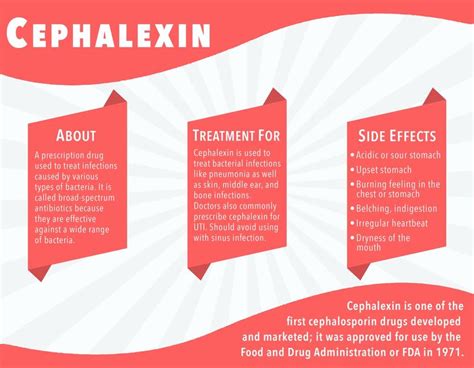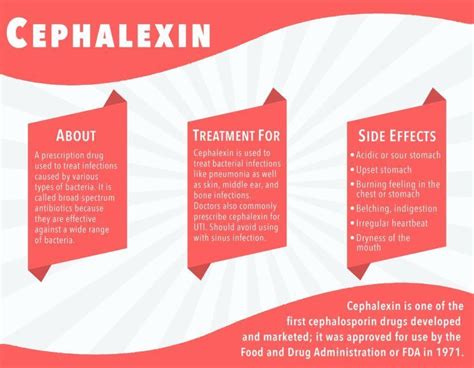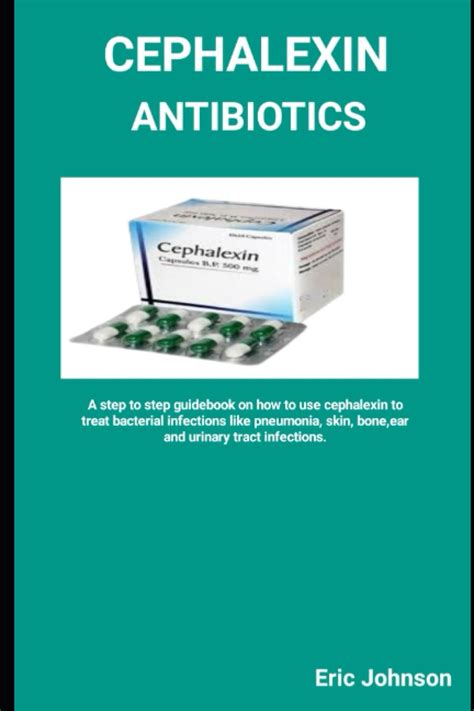Intro
Discover 5 common Cephalexin side effects, including allergic reactions, diarrhea, and stomach pain, and learn about antibiotic resistance, dosage, and interactions to ensure safe usage of this cephalosporin antibiotic.
The importance of understanding the potential side effects of medications cannot be overstated, especially when it comes to antibiotics like Cephalexin. Cephalexin, a cephalosporin antibiotic, is commonly prescribed to treat bacterial infections such as pneumonia, skin infections, and urinary tract infections. While it is effective against a wide range of bacterial infections, it can also cause a variety of side effects, some of which can be severe. It is crucial for patients to be aware of these potential side effects to ensure they can manage them properly and seek medical help when necessary.
Cephalexin works by inhibiting the synthesis of the bacterial cell wall, ultimately leading to the death of the bacteria. However, its impact is not limited to the bacteria; it can also affect the body in various ways, leading to side effects. The severity and likelihood of experiencing side effects can vary greatly among individuals, depending on factors such as the dosage, duration of treatment, and individual health conditions. Understanding these side effects is key to ensuring the safe and effective use of Cephalexin.
The management of side effects associated with Cephalexin involves a combination of medical supervision, patient awareness, and sometimes, adjustments to the treatment plan. Patients are advised to report any unusual symptoms to their healthcare provider promptly, as early intervention can prevent more serious complications. Moreover, being informed about the potential side effects can help patients adhere to their treatment regimen more effectively, as they are better equipped to manage any adverse reactions that may occur.
Common Side Effects of Cephalexin

Cephalexin, like other antibiotics, can cause a range of side effects, from mild to severe. Common side effects include diarrhea, nausea, vomiting, and abdominal pain. These gastrointestinal symptoms are among the most frequently reported side effects and can be managed with dietary changes, hydration, and, in some cases, anti-diarrheal medications. Additionally, patients may experience hypersensitivity reactions, such as rash, itching, and hives, which can be a sign of an allergic reaction to the medication.
Understanding Gastrointestinal Side Effects
The gastrointestinal side effects of Cephalexin are thought to be related to the disruption of the normal gut flora. This disruption can lead to an overgrowth of harmful bacteria, resulting in symptoms like diarrhea and abdominal pain. To mitigate these effects, patients are often advised to maintain a healthy diet, stay hydrated, and consider probiotics to support the recovery of beneficial gut bacteria.Severe Side Effects of Cephalexin

While less common, severe side effects of Cephalexin can include severe allergic reactions, such as anaphylaxis, which is a medical emergency requiring immediate attention. Other severe side effects may involve the liver and kidneys, including elevated liver enzymes and acute kidney injury. These conditions underscore the importance of monitoring liver and kidney function during treatment, especially in patients with pre-existing liver or kidney disease.
Managing Allergic Reactions
Allergic reactions to Cephalexin can range from mild to life-threatening. Patients who experience symptoms of an allergic reaction, such as difficulty breathing, swelling of the face, lips, tongue, or throat, or a severe rash, should seek medical help immediately. In cases of suspected allergy, alternative antibiotics may be prescribed, and patients are advised to carry an EpiPen or similar emergency device if prescribed by their healthcare provider.Long-Term Side Effects of Cephalexin

Long-term use of Cephalexin can lead to several complications, including the development of antibiotic-resistant bacteria. This resistance can make future infections harder to treat and increases the risk of spreading resistant bacteria to others. Additionally, prolonged antibiotic use can lead to an overgrowth of Candida, resulting in yeast infections, which may require antifungal treatment.
Preventing Antibiotic Resistance
Preventing antibiotic resistance involves the judicious use of antibiotics, adhering to the prescribed treatment regimen, and completing the full course of medication as directed by the healthcare provider. Patients should also practice good hygiene, such as frequent handwashing, to reduce the spread of infections and the subsequent need for antibiotics.Special Considerations

Certain populations, such as pregnant women, breastfeeding mothers, and individuals with kidney or liver disease, require special consideration when taking Cephalexin. For pregnant women, Cephalexin is generally considered safe, but it should only be used when clearly needed. Breastfeeding mothers should also consult their healthcare provider, as Cephalexin can pass into breast milk, although it is typically considered safe for the infant. Patients with kidney or liver disease may need dose adjustments to prevent accumulation of the drug and its metabolites.
Cephalexin in Pregnancy and Breastfeeding
The use of Cephalexin during pregnancy and breastfeeding should be approached with caution. While it is classified as a category B drug, meaning animal reproduction studies have failed to demonstrate a risk to the fetus and there are no adequate and well-controlled studies in pregnant women, the decision to use Cephalexin should be made after considering the potential benefits and risks. Similarly, for breastfeeding mothers, the potential benefits of Cephalexin for the mother should be weighed against the potential risks to the infant.Conclusion and Next Steps

In conclusion, while Cephalexin is an effective antibiotic for treating various bacterial infections, it is crucial for patients to be aware of its potential side effects. By understanding these side effects and taking proactive steps to manage them, patients can ensure a safer and more effective treatment experience. It is also important for patients to maintain open communication with their healthcare providers, reporting any concerns or unusual symptoms promptly.
We invite you to share your experiences or ask questions about Cephalexin and its side effects in the comments below. Your insights can help others better understand this medication and its implications. If you found this article informative, please consider sharing it with others who might benefit from this information.
What are the most common side effects of Cephalexin?
+The most common side effects of Cephalexin include diarrhea, nausea, vomiting, and abdominal pain. These gastrointestinal symptoms are usually mild and can be managed with dietary changes and hydration.
Can Cephalexin cause severe allergic reactions?
+Yes, Cephalexin can cause severe allergic reactions, including anaphylaxis, which is a medical emergency. Symptoms of a severe allergic reaction include difficulty breathing, swelling of the face, lips, tongue, or throat, and a severe rash. If you experience any of these symptoms, seek medical help immediately.
Is Cephalexin safe during pregnancy and breastfeeding?
+Cephalexin is generally considered safe during pregnancy and breastfeeding, but its use should be approached with caution. Pregnant women and breastfeeding mothers should consult their healthcare provider before taking Cephalexin to discuss the potential benefits and risks.
